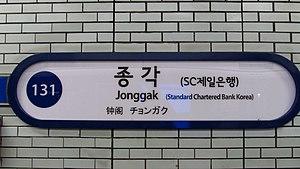131 Jonggak Station [Standard Chartered Bank Korea] | |||||||||||||||||||||||
|---|---|---|---|---|---|---|---|---|---|---|---|---|---|---|---|---|---|---|---|---|---|---|---|
 Station sign | |||||||||||||||||||||||
| Korean name | |||||||||||||||||||||||
| Hangul | 종각역 | ||||||||||||||||||||||
| Hanja | 鐘閣驛 | ||||||||||||||||||||||
| Revised Romanization | Jonggak-yeok | ||||||||||||||||||||||
| McCune–Reischauer | Chonggak-yŏk | ||||||||||||||||||||||
| General information | |||||||||||||||||||||||
| Location | 20-3 Jongno 1-ga, 55 Jongno Jiha, Jongno-gu, Seoul[1] | ||||||||||||||||||||||
| Operated by | Seoul Metro | ||||||||||||||||||||||
| Line(s) | Line 1 | ||||||||||||||||||||||
| Platforms | 2 | ||||||||||||||||||||||
| Tracks | 2 | ||||||||||||||||||||||
| Construction | |||||||||||||||||||||||
| Structure type | Underground | ||||||||||||||||||||||
| History | |||||||||||||||||||||||
| Opened | August 15, 1974[1] | ||||||||||||||||||||||
| Passengers | |||||||||||||||||||||||
| (Daily) Based on Jan-Dec of 2012. Line 1: 92,954[2] | |||||||||||||||||||||||
| |||||||||||||||||||||||
Jonggak Station is a station on the Line 1 of the Seoul Subway in South Korea. It is located on Jongno, central Seoul and comprises a large underground arcade.
The second-largest book shop in South Korea, the Bandi & Luni's lying under the Jongno Tower, which in turn is just above this station, is directly accessible from the station.
On every New Year's Day, the bell ceremony (Jeyaeui Jong Tajongsik) is held at Boshingak, the nearby bell pavilion. (The name of the station comes from this pavilion, jong meaning bell and gak pavilion.) At those times the area is so crowded with tens of thousands of Seoulites that trains do not stop at Jonggak as to avoid any accidents.
Station layout
| G | Street level | Exit |
| L1 Concourse | Lobby | Customer Service, Shops, Vending machines, ATMs |
| L2 Line 1 platforms | Side platform, doors will open on the left | |
| Southbound | → Line 1 toward Incheon or Sinchang (City Hall) → | |
| Northbound | ← Line 1 toward Soyosan (Jongno 3(sam)-ga) | |
| Side platform, doors will open on the left | ||
Surroundings
The following places are accessible from this station's exits as listed.
- Exit 1: Gwanghwamun; National Tax Office; U.S.A. Embassy; Seoul Fire and Accident Prevention Headquarters; Jongno Gu Office; Jongno Fire Station; Gwanghwamun Station (Line 5)
- Exit 2: Gongpyeon Dong; Anguk Dong; Jogyesa
- Exit 3: Insa Dong; Seoul YMCA
- Exit 4: Gwancheol Dong; Boshingak; Korea Development Bank
- Exit 5: Mugyo Dong; Gwanggyo; Insurance Agency; Korea Tourism Organization
- Exit 6: Seorim Dong; Gwanghwamun Post Office
References
- ^ Monthly Number of Passengers between Subway Stations Archived 2014-10-06 at the Wayback Machine. Korea Transportation Database, 2013. Retrieved 2013-10-15.